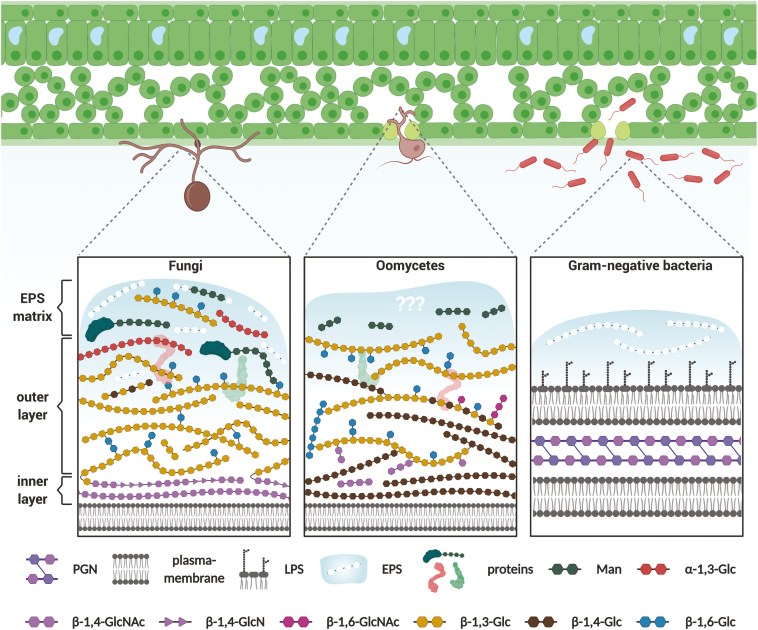Fig. 1.
Schematic overview of microbial cell surface glycans. Recognition of microbe-derived cell wall polysaccharides represents an important mechanism by which plants surveil their microbial surrounding. Since cell wall structure and function are highly interlocked, core polysaccharides are conserved within different microbial groups. This scheme illustrates these core polysaccharides and their linkage types without representing exact quantitative proportions. Cell walls of filamentous fungi and oomycetes are network-like structures consisting of highly interconnected polysaccharide fibrils. In fungi, the inner cell wall layer consists of chitin (β-1,4-GlcNAc) and chitosan polymers (β-1,4-GlcN). It is covalently linked to the outer cell wall layer, which is mainly composed of β-1,3/1,6-glucans (β-1,3/1,6-Glc) with minor amounts of β-1,4-glucose (β-1,4-Glc). The outer layer is concealed by α-1,3-glucans (α-1,3-Glc) and mixed-linkage mannose (Man) polymers. Mannose polymers often occur as heterosaccharides with minor amounts of additional sugar types (e.g. rhamnose and galactose). A highly mobile, gel-like extracellular polysaccharide (EPS) matrix is loosely attached to the outer cell wall of many fungi. In contrast to fungi, no detailed studies on the cell wall architecture of oomycetes have been performed. Cross-linked cellulose (β-1,4-Glc) and β-1,3/1,6-glucans are major components of the inner part of oomycete cell walls. Chitin (β-1,4- and β-1,6-GlcNAc) only occurs in minute amounts; most of it is assumed to be connected to β-glucan polymers. The cellulose content is reduced in the external parts of the cell wall. Instead, branched β-glucans and mannose oligomers are present in that layer. To our knowledge, no detailed information on the architecture of an EPS matrix in oomycetes has been reported. Peptidoglycan (PGN) is a conserved part of bacterial cell walls present in Gram-positive and Gram-negative bacteria. The main heteropolysaccharides consist of alternating N-acetylglucosamine (GlcNAc) and N-acetylmuramic acid residues, which are interconnected through peptide chains. In Gram-negative bacteria, PGN is embedded between an inner (plasma membrane) and outer membrane layer. The outer membrane layer is decorated with lipid-linked polysaccharides, so-called lipopolysaccharides (LPSs). An amorphous matrix made of EPSs (e.g. xanthan and succinoglycan) encases many bacterial species. A more detailed overview on microbial cell surface glycans and their implications on plant–microbe interactions can be found in Supplementary Table S1.

